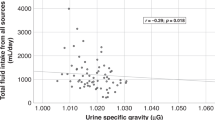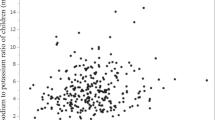Abstract
Background/Objectives:
The objective of the study is to describe the hydration status and to assess the main food- and/or fluid intake-associated factors in healthy adolescents.
Subjects/Methods:
A total of 194 adolescents from the city of Zaragoza aged 12.5–17.5 years (99 males) participating in the 'Healthy Lifestyle in Europe by Nutrition in Adolescence' (HELENA) cross-sectional study were included. First morning urine was collected, and osmolality was determined by freezing point depression osmometer. A self-reported computer-based 24-h dietary recall was applied the same day of the urine collection. Analysis of variance, Kruskal–Wallis procedure or Pearson’s χ2 analyses was used to examine the group associations.
Results:
Seventy-one percent of adolescents did not meet the European Food Safety Agency (EFSA) recommendations for average total water intake (TWI), and 68% had high first morning urine osmolality values. TWI and the proportion of those meeting EFSA reference values significantly (P<0.05) decreased with increased osmolality. Males who met the EFSA recommendations consumed significantly (P<0.05) more plain water (1035.13 vs 582.68 ml) and dairy drinks (368.13 vs 226.68 ml) than those who did not. In females, the consumption of water (1359.41 vs 620.44 ml) and sugar-sweetened beverages (214.61 vs 127.42 ml) was significantly higher in those meeting the EFSA recommendations than in those who did not. First morning urine osmolality was associated with vegetables (unstandardized β: −0.6; 95% confidence interval (CI): −1.02 and −0.18) and fruits intake (β: −0.41; 95% CI: −0.63 and −0.19) in males and with dairy drinks (β: −0.39; 95% CI: −0.76 and −0.02) and fruits (β: −0.41; 95% CI: −0.73 and −0.10) in females.
Conclusions:
There was a high prevalence of inadequate TWI and high urine osmolality among these Spanish adolescents. Lower urine osmolality was associated with higher consumption of vegetables in males, dairy drinks in females and fruits in both males and females.
This is a preview of subscription content, access via your institution
Access options
Subscribe to this journal
Receive 12 print issues and online access
$259.00 per year
only $21.58 per issue
Buy this article
- Purchase on Springer Link
- Instant access to full article PDF
Prices may be subject to local taxes which are calculated during checkout


Similar content being viewed by others
References
Jequier E, Constant F . Water as an essential nutrient: the physiological basis of hydration. Eur J Clin Nutr 2010; 64: 115–123.
Raman A, Schoeller DA, Subar AF, Troiano RP, Schatzkin A, Harris T et al. Water turnover in 458 American adults 40-79yr of age. Am J Physiol Renal Physiol 2004; 286: F394–F401.
Lopez RM, Casa DJ, Jensen KA, DeMartini JK, Pagnotta KD, Ruiz RC et al. Examining the influence of hydration status on physiological responses and running speed during trail running in the heat with controlled exercise intensity. J Strength Cond Res 2011; 25: 2944–2954.
European Food Safety Authority (EFSA). Scientific Opinion on Dietary Reference Values for water EFSA Panel on Dietetic Products, Nutrition, and Allergies (NDA). EFSA J 2010; 8: 1459.
Kempton MJ, Ettinger U, Foster R, Williams SC, Calvert GA, Hampshire A et al. Dehydration affects brain structure and function in healthy adolescents. Hum Brain Mapp 2010; 32: 71–79.
Alexy U, Cheng G, Libuda L, Hilbig A, Kersting M . 24 h-Sodium excretion and hydration status in children and adolescents—results of the DONALD Study. Clin Nutr 2012; 31: 78–84.
Food and Nutrition Board Dietary Reference Intakes: Water, Potassium, Sodium, Chloride, and Sulfate. The National Academic Press: Washington, DC, USA, 2004.
Sichert-Hellert W, Kersting M, Manz F . Fifteen year trends in water intake in German children and adolescents: results of the DONALD Study. Dortmund Nutritional and Anthropometric Longitudinally Designed Study. Acta Paediatr 2001; 90: 732–737.
Stookey JD, Brass B, Holliday A, Arieff A . What is the cell hydration status of healthy children in the USA? Preliminary data on urine osmolality and water intake. Public Health Nutr 2011; 15: 2148–2156.
Perrier E, Rondeau P, Poupin M, Le Bellego L, Armstrong LE, Lang F et al. Relation between urinary hydration biomarkers and total fluid intake in healthy adults. Eur J Clin Nutr 2013; 67: 939–943.
Duffey KJ, Huybrechts I, Mouratidou T, Libuda L, Kersting M, De Vriendt T et al. Beverage consumption among European adolescents in the HELENA study. Eur J Clin Nutr 2011; 66: 244–252.
Moreno LA, De Henauw S, Gonzalez-Gross M, Kersting M, Molnar D, Gottrand F et al. Design and implementation of the Healthy Lifestyle in Europe by Nutrition in Adolescence Cross-Sectional Study. Int J Obes (Lond) 2008; 32: S4–S11.
Beghin L, Castera M, Manios Y, Gilbert CC, Kersting M, De Henauw S et al. Quality assurance of ethical issues and regulatory aspects relating to good clinical practices in the HELENA Cross-Sectional Study. Int J Obes (Lond) 2008; 32: S12–S18.
Bar-David Y, Urkin J, Kozminsky E . The effect of voluntary dehydration on cognitive functions of elementary school children. Acta Paediatr 2005; 94: 1667–1673.
Manz F, Wentz A . 24- h hydration status: parameters, epidemiology and recommendations. Eur J Clin Nutr 2003; 57: S10–S18.
Stookey JD, Brass B, Holliday A, Arieff A . What is the cell hydration status of healthy children in the USA? Preliminary data on urine osmolality and water intake. Public Health Nutr 2012; 15: 2148–2156.
Vereecken CA, Covents M, Matthys C, Maes L . Young adolescents’ nutrition assessment on computer (YANA-C). Eur J Clin Nutr 2005; 59: 658–667.
Vereecken CA, Covents M, Sichert-Hellert W, Alvira JM, Le Donne C, De Henauw S et al. Development and evaluation of a self-administered computerized 24- h dietary recall method for adolescents in Europe. Int J Obes (Lond) 2008; 32: S26–S34.
Julian-Almarcegui C, Bel-Serrat S, Kersting M, Vicente-Rodriguez G, Nicolas G, Vyncke K et al. Comparison of different approaches to calculate nutrient intakes based upon 24- h recall data derived from a multicenter study in European adolescents. Eur J Nutr 2015, e-pub ahead of print 10 March 2015 doi:10.1007/s00394-015-0870-9.
Dini E, De Abreu J, Lopez E . Osmolality of frequently consumed beverages. Invest Clin 2004; 45: 323–335.
Nagy E, Vicente-Rodriguez G, Manios Y, Beghin L, Iliescu C, Censi L et al. Harmonization process and reliability assessment of anthropometric measurements in a multicenter study in adolescents. Int J Obes (Lond) 2008; 32: S58–S65.
Bar-David Y, Urkin J, Landau D, Bar-David Z, Pilpel D . Voluntary dehydration among elementary school children residing in a hot arid environment. J Hum Nutr Diet 2009; 22: 455–460.
Bellisle F, Thornton SN, Hebel P, Denizeau M, Tahiri M . A study of fluid intake from beverages in a sample of healthy French children, adolescents and adults. Eur J Clin Nutr 2010; 64: 350–355.
Libuda L, Alexy U, Sichert-Hellert W, Stehle P, Karaolis-Danckert N, Buyken AE et al. Pattern of beverage consumption and long-term association with body-weight status in German adolescents—results from the DONALD study. Br J Nutr 2008; 99: 1370–1379.
Feferbaum R, de Abreu k, Leone C . Fluid intake patterns: an epidemiological study among children and adolescents in Brazil. BMC Public Health 2012; 12: 1005.
Montenegro-Bethancourt G, Johner SA, Remer T . Contribution of fruit and vegetable intake to hydration status in schoolchildren. Am J Clin Nutr 2013; 98: 1103–1112.
Ebner A, Manz F . Sex difference of urinary osmolality in German children. Am J Nephrol 2002; 22: 352–355.
Remer T, Dimitriou T, Manz F . Dietary potential renal acid load and renal net acid excretion in healthy, free-living children and adolescents. Am J Clin Nutr 2003; 77: 1255–1260.
Stahl A, Kroke A, Bolzenius K, Manz F . Relation between hydration status in children and their dietary profile—results from the DONALD study. Eur J Clin Nutr 2007; 61: 1386–1392.
Van Hoeck K, Bael A, Lax H, Hirche H, van Gool JD . Circadian variation of voided volume in normal school-age children. Eur J Pediatr 2007; 166: 579–584.
Acknowledgements
The analysis was supported by a grant from Danone Research. We acknowledge Alexis Klein and Erica Perrier for their help in interpreting the results and reviewing the manuscript. We acknowledge all the adolescents who made possible the HELENA study with their participation.
Author information
Authors and Affiliations
Corresponding author
Ethics declarations
Competing interests
The authors declare no conflict of interest.
Rights and permissions
About this article
Cite this article
Iglesia, I., Santaliestra-Pasías, A., Bel-Serrat, S. et al. Fluid consumption, total water intake and first morning urine osmolality in Spanish adolescents from Zaragoza: data from the HELENA study. Eur J Clin Nutr 70, 541–547 (2016). https://doi.org/10.1038/ejcn.2015.203
Received:
Revised:
Accepted:
Published:
Issue Date:
DOI: https://doi.org/10.1038/ejcn.2015.203
This article is cited by
-
Afternoon urine osmolality is equivalent to 24 h for hydration assessment in healthy children
European Journal of Clinical Nutrition (2020)



